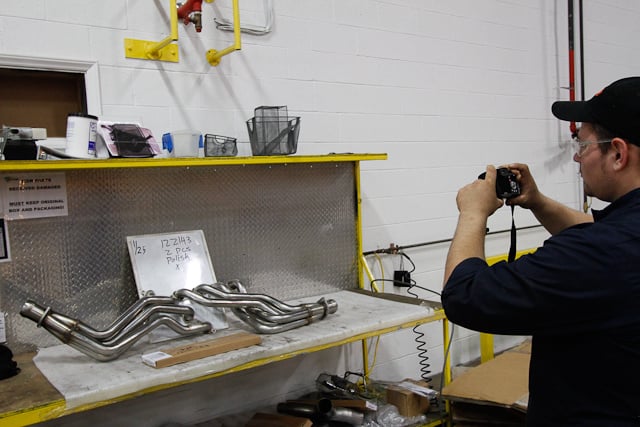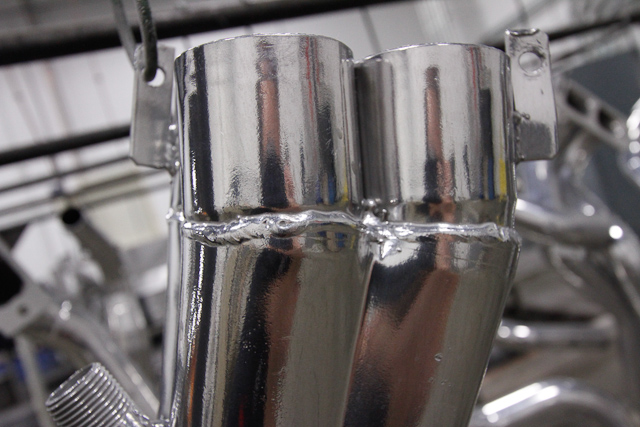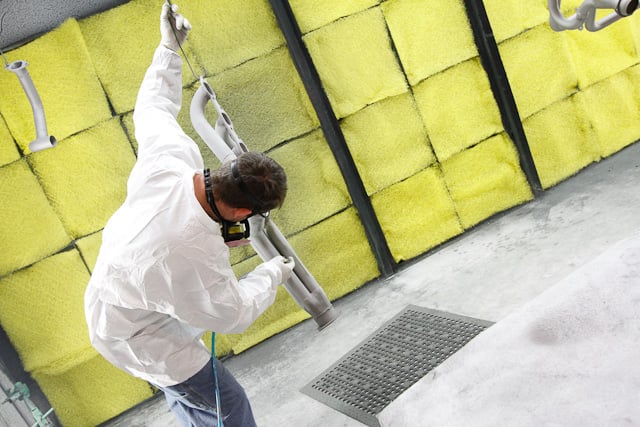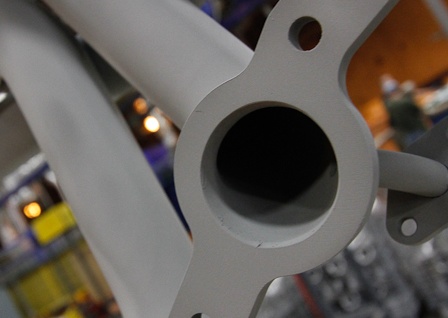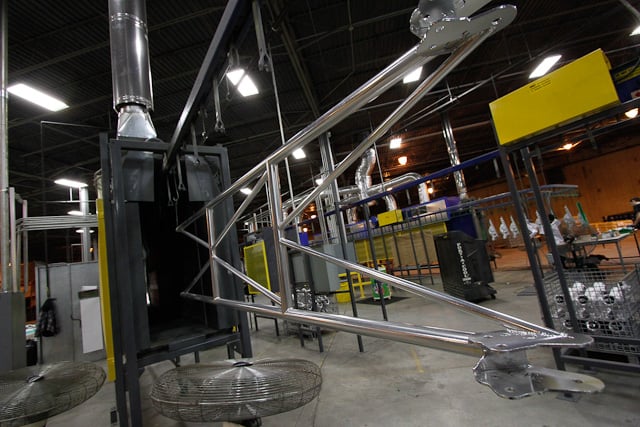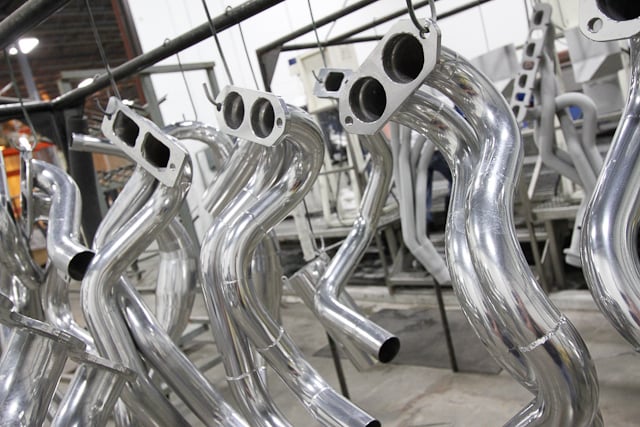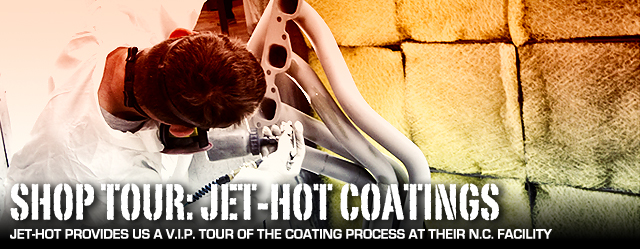 [1]
[1]
Whether you’re looking for a spectacular show-quality shine or superior performance on the track, professional coatings make a difference, and in the world of high performance street and racing vehicles, one of the leaders of the market is Jet-Hot [2].
Founded in the early 1980’s, Jet-Hot was largely focused on the military and commercial applications, delivering high performance coatings for fighter jets, aircraft carrier launch systems, combat vehicles, and the like. By the 1990’s, these coating technologies were parlayed into the automotive and motorsports realm, effectively reshaping the market focus for Jet-Hot. Today, the racing and car restoration business represents a significant part of Jet-Hot’s business, regarded as one of the leading high performance coating brands in the auto enthusiast and racing industries.
The team at Jet-Hot recently opened the doors to their corporate offices and primary coating facility in Burlington, N.C. to powerTV, allowing us to take an all-access tour of the coating facility and its intricate processes. On our tour, we were given a walk-through of every step of the coating process from start to finish, enabling us to share with you what goes on behind closed doors.
Receiving
As parts come in the door, they're inspected by a technician to determine their condition and to assign an identification number that will remain with the part during the coating processes and beyond. Every part is also photographed prior to going onto the line for record-keeping purposes.
Parts for coating are received from a number of different sources by Jet-Hot, including from individual customers and from manufacturers sending in new product in larger quantities.
In this receiving department, the team at Jet-Hot is ensuring that all of the parts were received via packing lists on the shipment or other shipping information. The 1-2 employees who generally comprise this department will inspect the product to ensure that no damage was done to the components during transit and to judge the overall condition of the product before it heads into the coating process.
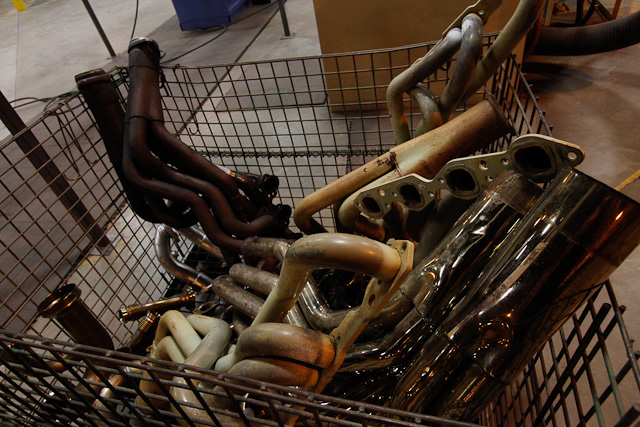 [5]
[5]Here, you can see a number of headers and other exhaust pipes in their before condition, which is often well-used and packing some rust.
After inspection, detailed photographs are taken of the parts in the condition they arrived in for record purposes and assigned a work order number attached to each product to maintain an identification on the part as it traverses through the coating process. These last steps also assist in identifying parts for warranty purposes in the future.
Once the part checks out, it’s sent down one of two lines that work their way through the Jet-Hot facility.
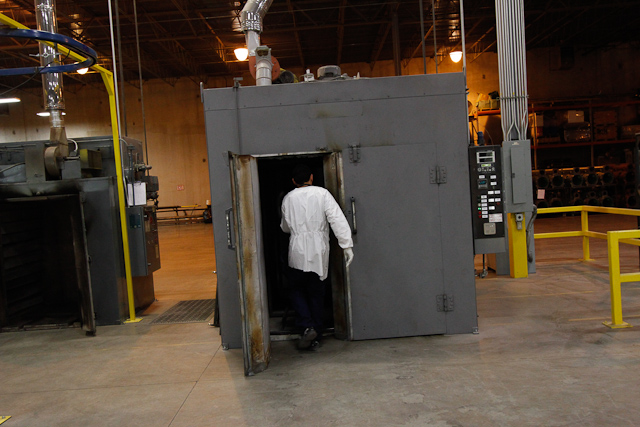 [6]
[6]Oils - particularly the inorganic kind that come from your skin upon handling- are an enemy to the adhesion of coatings, and therefore they must be burned off prior to the coating stage. To accomplish this, parts are placed in large ovens that bake these oils off at roughly 650 degrees Fahrenheit.
Cooking Instructions
As they arrive, parts are often in a number of different conditions, from brand new to well-used with thin layers of engine oil or other grime. Not only that, but the parts take on inorganic materials from handling, particularly the oils from one’s skin.
It’s these materials that can cause problems in the coating process, being as a water-based coating is utilized. Thus, before they can go any further, these materials and any other oily residues must be removed entirely.
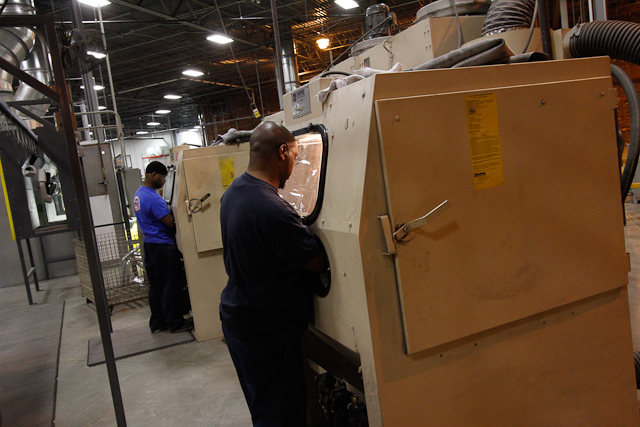 [7]
[7]Using these booths to contain the dust, parts are sanded using a grit-blasting process to remove the outer layers of paint or other materials applied to the part.
Sandblasting
After the parts have been washed via their respective method, they’re put through a grit-blasting process using an aluminum oxide grit material. According to Jet-Hot’s Dave Burton, “This process accomplishes two things: it cleans off any foreign material on the surface and takes it down to a white metal, and it provides more surface area for a better anchor pattern for adhesion of the coatings. On a part such as a set of headers, the tubes will be grit-blasted both inside and out.”
Within these products, a variation of coating methods used on a part can vary depending on the desired outcome of the part and whether it will receive a final color or a polish upon completion.
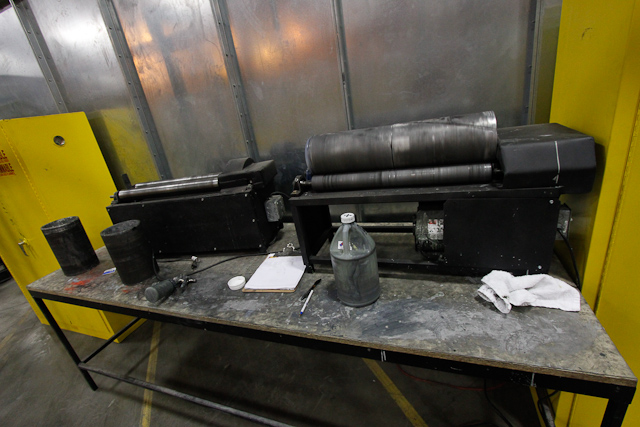 [9]
[9]At this station within the facility, Jet-Hot's different forms of coatings are mixed in preparation for application. Parts will receive a base coat, top coat, or both, while items such as headers will have an inner coat applied.
From the sandblasting process through being cured in an oven, virtually all parts are run through the plant on a conveyor. When they reach the coating booth, an operator pulls the part off of the line for full control and maneuverability around the part to coat it from the necessary angles to apply the coatings. Once the operator has performed the applications the part will go back onto the line and heads on its way.
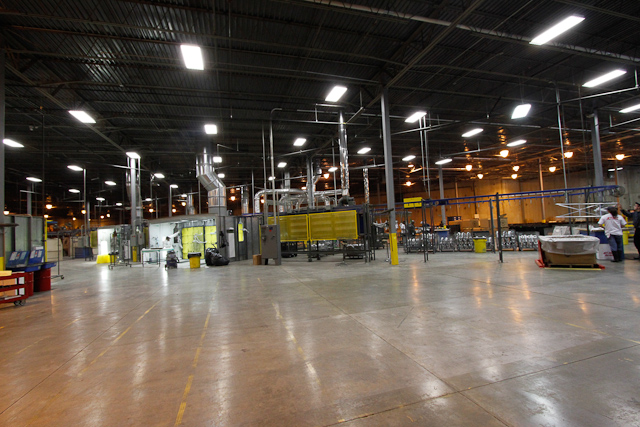 [10]
[10]This view provides a complete look at the core of Jet-Hot's Burlington facility. Parts work their way around the line seen at left, through coating booths and a number of infrared and convection ovens, including these seen on the left of the image.
Coating Stage
Once the parts arrive at the coating stage, they're pulled off the line by an operator, who will hang the part so that he or she has full control of the coating process, which is performed by hand using a traditional spray gun. At right, you can see a set of headers following the initial application of the base coat.
“Inner coats, as the name implies, are coatings that are applied to the inside of pipes on things like headers or other parts that air or fluid will flow through,” said Burton. “Not only does this create an added layer of protection, but improved flow through the pipes and therefore more performance.”
Known at Jet-Hot as Flow Coating, this inner coating is applied throughout the inside of the header tubes and collector, creating a uniform heat passage regardless of the finish. In a polished header, this coating will improve the airflow through the pipes.
“This is possible because you’re smoothing out the inside of the header pipes,” explains Burton. “This occurs from going through a polishing process where you’re physically beating down and polishing the aluminum and you get a really slick surface that improves the turbulence inside the header.”
Curing
After the coating has been applied, parts continue on down the line to a curing process that’s done in two different methods: an infrared oven (which the G8 headers were sent through) and a convection oven to cure the coatings. Interestingly, the technology used in Jet-Hot’s infrared oven actually allows parts to be cured in one-sixth of the time that they would under normal circumstances in normal convection technology. As Burton explains, this is a huge benefit to the customer.
Once the base coats have been applied, they must be cured using heat. This is accomplished in two ways, depending on the size of the part in question. Things like headers and similarly-sized components will go through an infrared oven, which features technology that cuts down tremendously on cure time, while larger parts will be moved to larger conventional ovens, where they'll spend an hour and a half curing. At left is a set of headers going into the infrared oven, and at right is a set of wheelie bars coming out.
“Parts can be cured in roughly twenty minutes rather than an hour and a half, so we can rapidly move parts through the plant and get them back in the hands of the customer,” said Burton. In general, only larger parts that won’t fit in the infrared oven are placed into the conventional batch oven for curing.
Applying The Color And Polish
Jet-Hot’s coatings are available in a number of different colors, and it’s after the curing process where this all comes to fruition.
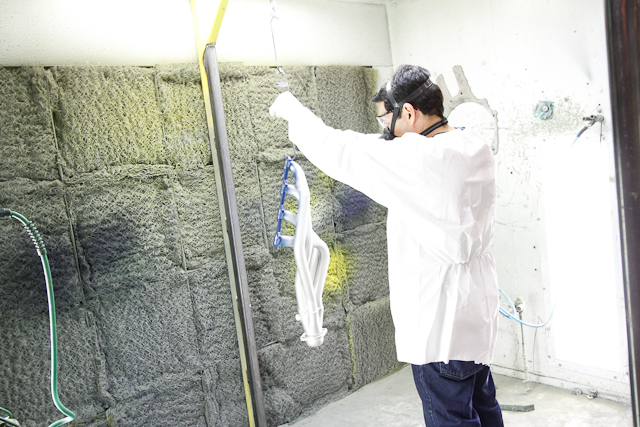 [16]
[16]Jet-Hot's coatings are available in a number of different colors, from traditional blacks and grey's to red, blue, green, and other colors to fit your tastes. To apply these, once the base coat on a part is cured, it's sandblasted using a light grit sandpaper to create a proper adhesion surface. The top layer of coating containing the color is then applied by hand, just as the base coat was.
Once the base coat has been applied and cured, parts head back to the sandblasting department, where they’re burnished with a very light grit-blast to roughen the surface. A top coat containing the color is then applied in the coating booth – by hand using a conventional spray gun – and inspected for quality before being sent to the shipping department. Polished parts, meanwhile, aren’t done just yet.
Utilizing an interesting piece of equipment sometimes referred to as a tumbler containing a media that’s vibrating and rolling inside of the machine. Headers, wheelie bars and the like are placed in this and left to run for a period of 10 to 20 minutes, where the media inside compresses the base coat on the part to create a polished finish through the vibrating and rolling contact. In doing so, the part is being mechanically polished.
It's hard to top the pristine look of a set of polished headers. Parts such as these are placed in a machine filled with soap and media that rolls, tumbles, and vibrates to create the polished finish. After this process, they're also lightly hand-polished to finish out any imperfections.
After going through the tumbler, a technician removes the part and rinses off the soap and retrieves any errant particles from inside the pipes before engaging in a hand-polishing process to give it one final, detailed touch.
powerTV Uses Jet-Hot Coatings
We have known of Jet-Hot coatings for many years and like others, believe in their product. The first use of Jet-Hot’s coatings on one of our projects was for our ’71 Nova called “Swinger”. This project car has little expense spared; with a fresh paint job, Pro-Touring-inspired Ridetech suspension, and powered by a LSA E-rod crate engine. Since the LSA didn’t have an exhaust kit made for it yet in this configuration, we turned to a Flowmaster U-Build kit for our solution.
With the kit welded together, we knew that the exhaust needed additional form and function, thus we shipped our complete exhaust to Jet-Hot to get coated. Not only does the completely coated exhaust look good, it will also keep the heat under control, while holding up for many years to come.
Our Jet-Hot coated '71 Nova Exhaust
As an industry leader in high performance coatings and one that racers and manufacturers the world over rely on, you can see that the team at Jet-Hot have the coating process down to a science that only years of experience can deliver. But while Jet-Hot hasn’t necessarily reinvented the wheel in their coating process, it’s the virtually unrivaled technology behind their coatings and attention to every last detail that’s created a lasting and respected image around the automotive and racing community.
